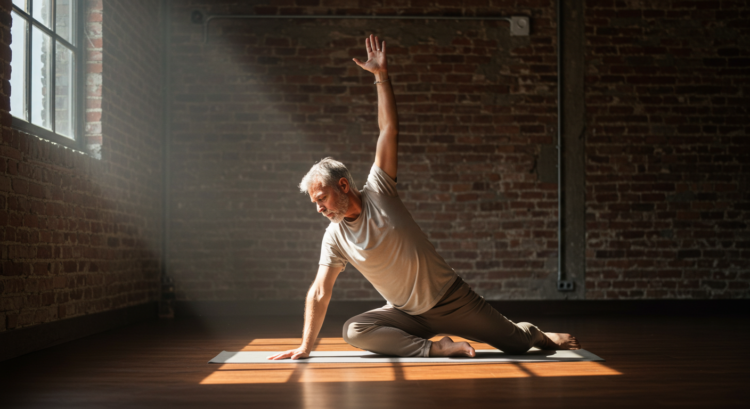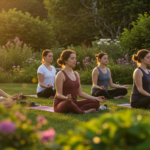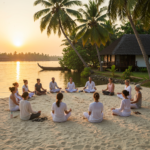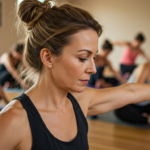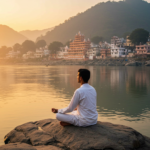Escape to the Blue Ridge: Seeking Happiness High in the Hills
In the relentless hum of modern life, amidst the pinging notifications and never-ending to-do lists, where do we turn to find genuine peace? That elusive sense of calm, that deep, abiding happiness – it often feels just out of reach, lost somewhere between yesterday’s regrets and tomorrow’s anxieties. Many of us find ourselves yearning for a pause button, a dedicated space to reconnect with ourselves and rediscover the joy that seems to have faded into the background noise. This universal quest for inner stillness and contentment leads many down the path of wellness, seeking sanctuaries where the world’s demands can momentarily cease, allowing the quiet whispers of the soul to be heard.
VISIT THE RETREAT WEBSITE FOR MORE
INFORMATION & PRICES
Imagine, then, escaping to a place nestled high in the embrace of ancient mountains, where the air feels cleaner, the silence deeper, and the horizon stretches endlessly, inviting contemplation. This is the promise of the Art of Living Retreat Center, perched majestically in the Blue Ridge Mountains of Boone, North Carolina. The journey itself often marks the beginning of the transition. As you wind your way up the scenic mountain roads, perhaps through a gentle mist that softens the edges of the world as described by some visitors, you feel a palpable sense of leaving the everyday behind, ascending towards something different, something potentially transformative. This isn’t just any wellness destination; it’s a sprawling 380-acre sanctuary of pristine forest, a place intentionally designed for deep rest and rejuvenation.
The sheer beauty of the location is undeniable and consistently highlighted by those who visit. Whether your gaze falls upon the stunning panoramic vistas of the rolling Blue Ridge peaks or settles on the quiet magic of the dense surrounding forest, nature here isn’t merely a backdrop; it feels like an active participant in the healing process. The tranquility is profound, offering an immediate respite from urban clamor and mental clutter. It’s within this serene setting that the center offers its specific promise: the 3-Day Art of Living Happiness Retreat. This program isn’t shy about its objective – it aims to equip participants with practical techniques to boost energy, calm the relentless chatter of the mind, manage stress effectively, and ultimately, cultivate a more profound and lasting sense of happiness and enthusiasm. At its heart lies a powerful, scientifically studied breathing technique known as SKY Breath Meditation, hinted at as the key to unlocking this inner reservoir of peace and joy. The very name “Happiness Retreat” sets a high bar, a bold invitation to explore whether such profound shifts are possible in just a few days. It beckons those searching for more than just relaxation, promising tools for a fundamental transformation.
Finding Your Mountain Nest: Comfort, Calm, and Community
Arriving at the Boone Wellness Center, you step into an environment designed to foster tranquility. The check-in process is typically smooth, ushering you into a campus that blends functional buildings with thoughtful design touches. The main meditation hall, for instance, follows ancient architectural principles intended to lift the spirit and focus the mind, hinting at the intentionality behind the space. The overall atmosphere strikes most visitors as deeply peaceful, serene, and welcoming. There’s a palpable sense of calm that permeates the grounds, reinforced by the natural beauty and the quiet dedication of those around you. The Art of Living philosophy emphasizes representing a “one-world family,” and this often translates into a supportive and kind environment, noted by many guests who interact with the staff and volunteers, often described as genuinely happy and embodying the principles taught.
When it comes to laying your head down at night, the center offers a few distinct options, catering to different preferences and lengths of stay. The Retreat Rooms are the simpler choice, furnished typically with twin beds, a private bathroom, and basic amenities like Wi-Fi and complimentary tea and coffee. These rooms are often described as comfortable and functional, ideal for those prioritizing inner work and connection with nature over luxurious surroundings. Some reviewers have characterized this style as akin to a “glorified summer camp,” suggesting that potential guests should manage their expectations accordingly, especially if they anticipate high-end resort comforts. Facilities in these areas might feel a bit “tired” to some observers, reflecting perhaps the operational realities of a non-profit organization where resources might be prioritized towards programs and outreach.
Alternatively, the Hotel Rooms offer a step up in amenities, usually featuring a king bed or two full beds, a flat-screen TV, a refrigerator, and often, more expansive views of the mountains or forest. These provide a more conventional hotel experience while still being immersed in the retreat environment. For those planning longer stays, apartment-style accommodations with kitchenettes and other conveniences are also available. Regardless of the room type, guests appreciate the cleanliness, the quality of essentials like showers (noted for good pressure and temperature by one visitor), and thoughtful touches such as pleasant aromatherapy bath products.
Beyond the private rooms, the center provides access to shared amenities that enhance the stay. Guests can utilize a fitness room, explore numerous hiking trails winding through the beautiful 380-acre property, relax in the garden, or simply find a quiet spot on the grounds for reflection. The Shankara Ayurveda Spa, a significant feature of the center, offers a range of therapeutic treatments (more on that later). A particularly appreciated spot mentioned by visitors is the cozy tea lounge within the spa building, offering a welcoming space to enjoy complimentary coffee or a variety of loose-leaf teas throughout the day.
VISIT THE RETREAT WEBSITE FOR MORE
INFORMATION & PRICES
ccommodation style, while clean and sufficient for many, does point towards an interesting aspect of the center. The simplicity could be an intentional choice, encouraging guests to turn their focus inward rather than outward towards material comforts. It might also reflect the center’s non-profit status, where function and accessibility are prioritized. This blend of dedicated wellness programming within a potentially more basic physical structure means the ideal guest is likely someone who values the substance of the retreat over opulent surroundings. Furthermore, the communal aspects, from shared dining spaces to group activities like Kirtan, suggest that connection and shared experience are integral parts of the design, offering a balance between solitary introspection and community engagement.
A Taste of Tranquility: Fueling the Journey Within
The dining experience at the Art of Living Retreat Center is consistently lauded and appears to be far more than just a way to refuel between sessions; it’s woven into the very fabric of the retreat’s holistic philosophy. Meals are served buffet-style in the main dining hall, a space designed to impress not only with its food but also with its architecture and breathtaking panoramic views of the mountains and sunrise. Many guests describe the combination of the nourishing food and the stunning vistas as a feast for both the eyes and the belly, making meal times a highlight of their stay.
The philosophy behind the food is deeply rooted in Ayurvedic principles. The emphasis is on eating “nature” – real, wholesome food imbued with ‘prana,’ or life force. The chefs are guided by the idea that food prepared with love, both for the planet and for the person being nourished, is the most beneficial. Consequently, all meals are vegetarian, with many vegan and gluten-free options readily available. The culinary influences are diverse, drawing inspiration from the local Appalachian harvest, traditional Indian cuisine (from Bombay, as one source mentions), and even Caribbean flavors, resulting in creative, flavorful, and deeply satisfying dishes. Sample menus hint at the variety: warming soups like Northern rosemary white bean or sweet potato and sage; vibrant salads featuring ingredients like Waldorf elements, sun-dried tomatoes, kale, or roasted roots; and inventive entrees such as semolina cakes with chutney, bean and lentil cakes with compote, or chickpea stew. Fresh fruits and vegetables, some potentially sourced from the center’s own garden, feature prominently.
The commitment to a specific wellness path is evident in the property-wide policies: the entire campus is meat-free, alcohol-free, and smoke-free in public spaces. This creates a clean, focused environment conducive to the retreat’s aims. While guests are permitted to discreetly consume alcohol in the privacy of their own rooms, the public stance reinforces the atmosphere of purification and mindfulness. The kitchen is also accommodating to common dietary restrictions, routinely catering to allergies such as gluten, dairy, nuts, and soy, ensuring at least one suitable entree option is available for those with specific needs.
However, the distinct culinary style, while praised for its healthfulness and flavor by many, might require a small adjustment for some. One reviewer noted that guests “must like Indian vegetarian food,” suggesting a prominent flavor profile that, while delicious to many, might not suit every palate accustomed to different cuisines. Adding to the communal, slightly less formal feel, guests are typically expected to bus their own trays after meals, reinforcing the “summer camp” comparison made by some and contributing to the shared, participatory nature of the experience. Overall, the food is presented not merely as sustenance but as a vital component of the wellness journey, intentionally crafted to nourish body, mind, and spirit in alignment with the retreat’s core principles.
The Breath That Unlocks Joy: Discovering Sudarshan Kriya
At the very core of the Art of Living Happiness Retreat lies the promise of transformation through breath. This isn’t just about deep breathing in the general sense; it centers around a specific, powerful technique known as Sudarshan Kriya, or SKY Breath Meditation. This technique is the cornerstone of the retreat and the Art of Living philosophy itself, which posits that true peace and happiness are found not in external circumstances but within, accessible through practical, self-empowering tools that help us navigate the stresses of modern life and anchor ourselves in the present moment.
The Art of Living organization, founded in 1981 by Gurudev Sri Sri Ravi Shankar, operates globally with a mission to foster a stress-free, violence-free society. Its approach blends ancient Vedic wisdom with contemporary needs, offering techniques rooted in Ayurveda, meditation, and particularly, breathwork. The philosophy emphasizes a “one-world family,” promoting human values and service alongside personal development. Sri Sri Ravi Shankar, a globally recognized humanitarian and spiritual leader, is said to have cognized the Sudarshan Kriya technique during a period of silence in 1982. Since then, it has become the centerpiece of Art of Living programs, reaching millions worldwide. The organization positions itself as educational and humanitarian, engaging in various service projects alongside its wellness programs.
So, what exactly is this much-talked-about SKY Breath Meditation? It’s described as a potent practice involving specific, rhythmic cycles of breathing that tap into the body’s natural rhythms to release deep-seated stress, energize the system, and bring the mind into a state of focused calm. Learning SKY typically involves understanding its distinct components. The process often begins with Ujjayi or “Victorious Breath,” a slow, controlled technique (around 2-4 breaths per minute) where you consciously feel the breath gently touching the back of the throat. This practice is known to induce a state of calm alertness. Following this might be Bhastrika or “Bellows Breath,” a more vigorous practice involving rapid, forceful inhalations and exhalations (about 30 per minute), which tends to create a feeling of excitation followed by deep calm. The sequence also incorporates the chanting of “Om” with prolonged exhalations, believed to enhance physiological alertness and sensory awareness. Finally, the core Sudarshan Kriya involves specific cyclical patterns of breath, guided through slow, medium, and fast rhythms.
The experience of learning and practicing SKY during the retreat is often described as profound. Participants speak of reconnecting with an inner calm they thought was lost, finding a sense of balance amidst life’s pressures, and experiencing moments of genuine tranquility. The technique is presented as a key to getting “unstuck” from negative thought patterns and emotional loops, allowing individuals to access their own inner power and freedom. It’s not just about feeling good momentarily; the retreat aims to provide tangible tools that participants can use daily to actively replace stress with joy and cultivate resilience.
VISIT THE RETREAT WEBSITE FOR MORE
INFORMATION & PRICES
Crucially, the Art of Living heavily emphasizes the scientific validation behind SKY. They frequently mention the existence of over 100 independent, peer-reviewed studies investigating its effects. This research, accessible through platforms like PubMed, suggests a wide range of benefits. Studies indicate that regular SKY practice can lead to significant reductions in stress (lowering cortisol levels), anxiety, and symptoms of depression. Participants often report improved sleep quality and duration, increased feelings of optimism, well-being, and social connectedness. Physiological markers also show positive changes, such as improved heart rate variability (HRV), a key indicator of autonomic nervous system balance and stress resilience. Research has explored its potential benefits for various populations, including university students, physicians experiencing burnout, individuals with PTSD, and those with mild-to-moderate depression and anxiety disorders. This focus on evidence-based benefits allows SKY to appeal not only to those seeking spiritual growth but also to individuals looking for practical, validated methods to improve their mental and physical health. Learning SKY is thus framed as acquiring a life-transforming skill, a powerful tool for self-regulation and enhancing overall quality of life, backed by both ancient wisdom and modern science. The implication is clear: the retreat provides the initial training, but the real power unfolds with continued, consistent practice.
Daily Rhythms: Yoga, Meditation, and Melodious Chants
Life at the Art of Living Happiness Retreat unfolds with a gentle yet purposeful rhythm, designed to immerse participants fully in the practices and philosophy. The days typically begin early, often around 7:30 AM, starting with sessions focused on breathwork and yoga, setting a mindful tone for the hours ahead. The schedule is quite structured during core program hours, weaving together various modalities to create a holistic experience.
A key component of the daily routine is Sri Sri Yoga. This isn’t the intense, athletic yoga often found in gyms; rather, it’s described as a gentle, holistic, hatha-style practice suitable for all levels, from complete beginners to seasoned practitioners. The focus is on integrating mind, body, and spirit, emphasizing breath awareness and mindful movement. One participant described a private session tailored to her needs (due to being the only attendee at that time) as incredibly healing, focusing on breath and only about 80% physical effort. The instructor, with decades of experience, guided her through a slow, quiet practice that left a profound impact, highlighting the potential depth and personalization available within the Sri Sri Yoga framework. It aims to energize the body while calming the mind, preparing participants for deeper meditative states.
Beyond the yoga mat, the schedule includes dedicated sessions for mindfulness and guided meditation, further cultivating inner stillness and present-moment awareness. Talks and workshops delve into the underlying principles, with titles like “The Secret of the Breath” and “The Rhythms of Life” suggesting explorations into the core philosophies and techniques being taught. While the specific content of these workshops isn’t always detailed in advance descriptions, they form part of the educational structure designed to deepen understanding alongside experiential practice.
As evening descends, a different kind of energy fills the air with the nightly Kirtan, or meditative chanting. This is often a highlight for many, offering a powerful communal experience. Typically lasting around 45 minutes, these sessions involve call-and-response singing of ancient chants and mantras, often accompanied by traditional instruments like the harmonium, drums, and tambourines played by participants or facilitators. The atmosphere is generally described as relaxing, joyful, and deeply connecting. For those unfamiliar with chanting, it might feel a bit unusual at first, as one reviewer noted, suggesting it’s good to know this is an integral part of the experience. However, many find the repetitive nature of the mantras and the shared vocal expression to be a profoundly calming and uplifting way to end the day, fostering a sense of unity and shared devotion within the group.
This combination of dynamic breathwork (SKY), gentle physical practice (Sri Sri Yoga), quiet contemplation (meditation), and expressive chanting (Kirtan) creates a rich tapestry of experiences. The structured nature of the schedule ensures participants are consistently engaged with these different facets of well-being, fostering an immersive environment. While some might find the schedule intense, the variety aims to cater to different aspects of the human experience – physical, mental, emotional, and spiritual – providing multiple avenues toward the retreat’s goal of enhanced happiness and inner peace.
Moments In Between: Nature, Nurturing, and New Connections
While the core schedule of the Art of Living Happiness Retreat is packed with structured sessions focused on breathwork, yoga, and meditation, the experience extends beyond these formal activities. The moments in between offer valuable opportunities for personal reflection, connection with nature, optional enrichment, and nurturing self-care. The center acknowledges that guests may seek different balances, supporting both community engagement and the need for solitude.
For those looking to add variety or delve into specific interests, the retreat center offers a range of optional activities, though some may come with additional fees. Guided nature walks allow participants to further explore the stunning 380-acre property and connect with the surrounding Blue Ridge Mountains. Ayurveda cooking demonstrations provide insights into the food philosophy practiced at the center. Creative outlets are also available, such as pottery classes in the onsite studio (where guests can often keep their creations) or watercolor painting sessions. These activities provide alternative ways to practice mindfulness and engage the senses. An outdoor Labyrinth offers another unique space for quiet contemplation and finding meaning through a meandering path.
Of course, many participants use the downtime simply to rest, integrate the teachings, or immerse themselves in the serene natural environment. The extensive grounds, with their well-maintained hiking trails, invite exploration and quiet walks amidst the forest’s magic. Finding a peaceful spot to sit, perhaps overlooking the mountains or beside a rustling stream, can be as beneficial as any formal session. The aforementioned tea lounge also provides a cozy nook for quiet contemplation or casual conversation. While the schedule is full, there is an understanding, as one reviewer pointed out, that individuals need to be comfortable with some level of self-direction during these unstructured periods.
The human element is also crucial. The retreat provides ample opportunities to connect with fellow attendees who are often on similar journeys of self-discovery. Shared meals and group sessions naturally foster conversation and camaraderie. The instructors, collectively referred to as the “Art of Living Faculty,” are generally described by guests as knowledgeable, kind, supportive, and genuinely living the principles they teach. Their guidance during sessions like the personalized Sri Sri Yoga class mentioned earlier can be deeply impactful. However, it’s worth noting that experiences can sometimes vary. While most guest accounts praise the staff, at least one online report, purportedly from a former employee, offered sharp criticism of management practices, particularly within the spa and dining hall, alleging a disconnect between the center’s public image and internal realities. While this appears to be an outlier compared to guest reviews, it serves as a reminder that any organization has internal complexities.
For those seeking deeper relaxation and pampering, the Shankara Ayurveda Spa is a significant draw. Highly rated and integrated with the center’s wellness philosophy, the spa offers a range of therapeutic treatments, including massages and facials, often incorporating Ayurvedic principles. Visitors describe the treatment rooms as beautiful and the experiences as deeply relaxing and rejuvenating, providing another layer of nurturing care to complement the core retreat program. These optional activities and amenities allow participants to tailor their experience, balancing the intensity of the core program with rest, recreation, and deeper self-care, though potentially adding to the overall cost.
An Honest Look: Weighing the Experience
When considering the 3-Day Art of Living Happiness Retreat, the overwhelming sentiment expressed in direct participant reviews and testimonials is positive, often glowingly so. People frequently describe their experience as transformative, rejuvenating, and deeply peaceful. Words like “clarifying,” “reset button for the soul,” and “best decision ever” appear in feedback. The connection with nature in the stunning Blue Ridge Mountains setting, the high quality and nourishing vegetarian food, the palpable sense of community, and the effectiveness of the core techniques – particularly the SKY Breath Meditation and the gentle Sri Sri Yoga – are consistently cited as highlights. Many leave feeling equipped with practical tools and a renewed sense of calm and enthusiasm.
However, a balanced perspective requires acknowledging potential downsides and managing expectations. The most common point of caution relates to the accommodation, specifically the Retreat Rooms. The description “glorified summer camp style” suggests that those anticipating luxury hotel standards might be disappointed. While clean and functional, the facilities are generally simpler and perhaps show signs of age in some areas. This aligns with the center’s non-profit nature and likely focus on program delivery over infrastructure opulence. Similarly, while the Ayurvedic-inspired vegetarian food is widely praised, its specific style, potentially leaning towards Indian flavors, might not appeal universally. The structured, relatively intense schedule might also feel demanding for those seeking a more leisurely pace, and navigating the unstructured downtime requires a degree of self-direction.
Furthermore, anyone researching the Art of Living organization more broadly is likely to encounter criticisms and controversies online that exist beyond the specific experiences at the Boone Wellness Center. Accusations of the organization operating like a ‘cult,’ employing overly persistent recruitment tactics, or fostering an environment of personality worship around its founder, Sri Sri Ravi Shankar, appear in various online forums and discussions. Some ex-members describe pressure to enroll others or devote excessive time and resources to the organization. There was also a significant environmental controversy several years ago involving a large event organized by the foundation on the Yamuna river floodplain in India, which drew criticism from environmental groups and resulted in legal action by the National Green Tribunal, though the Art of Living strongly contested the findings of environmental damage and defended its actions. The organization has also engaged in legal action against critical bloggers in the past.
It’s important to place these criticisms in context. They often relate to the broader international organization, deeper levels of involvement beyond introductory retreats, or specific past events, rather than directly reflecting the typical 3-day Happiness Retreat experience in North Carolina, which generally garners positive feedback from attendees focused on the wellness program itself. However, awareness of this wider context is relevant for potential participants doing their due diligence. The Art of Living maintains its own resources addressing criticisms and highlighting its extensive humanitarian work globally. Ultimately, prospective guests must weigh the overwhelmingly positive reports about the retreat experience itself against the more complex reputation of the parent organization. For most attendees focused on the 3-day program, the experience seems centered on learning valuable wellness techniques in a supportive and beautiful environment, but awareness of the broader discussions allows for a more informed decision.
Bringing the Mountain Home: Lasting Peace or Fleeting Feeling?
A weekend retreat can feel like a blissful escape, a temporary haven from the storms of everyday life. But the true measure of its value often lies in what happens after you descend the mountain and return home. Does the peace evaporate as soon as you reconnect to Wi-Fi, or can the tranquility take root and blossom in your daily routine? The Art of Living Happiness Retreat seems acutely aware of this challenge, explicitly designing its program not just for an immediate boost but for lasting change.
A key element underscoring this intention is the focus on integration. The schedule includes a dedicated session towards the end, often titled something like “New start: Home practice,” aimed specifically at helping participants understand how to incorporate the learned techniques, especially the cornerstone SKY Breath Meditation, into their lives back home. The retreat emphasizes providing practical “tools to use in your daily life,” framing the experience as skill acquisition rather than just passive reception. The goal isn’t simply to feel happy for three days, but to learn how to cultivate happiness from within, consistently.
This aligns with the ambitious stated goal of helping participants “create lasting happiness.” Can a 3-day program truly deliver on such a profound promise? The answer likely lies less in the retreat itself and more in the participant’s commitment afterward. The retreat acts as an incubator, a powerful catalyst providing the knowledge, the initial experience, and the supportive environment to kickstart a new habit. The research surrounding SKY Breath Meditation supports the potential for sustained benefits, but these studies invariably involve participants continuing the practice regularly over weeks or months. Findings show significant improvements in stress levels, anxiety, depression, sleep, and overall well-being that persist well beyond the initial training period – if the practice is maintained. Studies tracking outcomes at 8 weeks, 2 months, and even 24 weeks post-intervention demonstrate that consistent home practice is key to realizing the long-term potential.
Therefore, the “lasting happiness” offered is conditional. The retreat provides the map, the compass, and the initial fuel, but the journey must be continued independently. It equips participants with a powerful technique, but the responsibility for using that tool rests with them.
Who, then, stands to benefit most from this particular North Carolina Yoga Retreat? It seems ideal for individuals genuinely open to exploring breathwork as a primary modality for change. Those seeking concrete techniques for stress reduction, emotional regulation, and enhanced mental clarity will find a structured, evidence-informed approach. Comfort with a disciplined program, simple (though clean) accommodation, and a wholesome vegetarian diet are important practical considerations. The retreat explicitly welcomes everyone, from those entirely new to meditation and yoga to individuals with long-established practices, suggesting the core techniques have broad applicability. It offers a potent blend of intensive learning, supportive community, and immersion in nature, providing a strong foundation for anyone committed to integrating these practices into their life for sustained well-being.
Final Thoughts from the Mountaintop
Leaving the Art of Living Retreat Center often feels like carrying a piece of the mountain’s serenity back with you. The experience is a unique blend: the undeniable power of the SKY Breath Meditation technique, the gentle grounding of Sri Sri Yoga, the communal upliftment of Kirtan, the deep nourishment of thoughtfully prepared food, and the constant, calming presence of the Blue Ridge Mountains. It’s an immersive dive into practices designed to quiet the mind, open the heart, and reconnect you to an inner source of peace and vitality.
The 3-Day Art of Living Happiness Retreat delivers a structured, supportive environment to learn potent tools for managing stress and enhancing well-being. While the accommodation may be simple, the setting is magnificent, and the core teachings offer a pathway toward greater self-awareness and emotional resilience. It’s an invitation to step away from the noise, tune into the rhythm of your own breath, and discover the potential for a calmer, brighter state of being – a potential that, with continued practice, can extend far beyond the weekend escape. It offers not just a temporary respite, but a tangible skill set for navigating life with greater ease and, perhaps, a more enduring sense of happiness.

